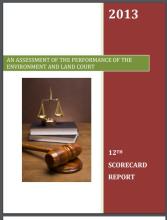Land Library
Welcome to the Land Portal Library. Explore our vast collection of open-access resources (over 74,000) including reports, journal articles, research papers, peer-reviewed publications, legal documents, videos and much more.
/ library resources
Showing items 1495 through 1503 of 1573.The Siwalik Hills is one of the most fragile and vulnerable ecosystems in the Nepalese Himalaya where soil erosion and land degradation issues are fundamental. There is very limited knowledge on soil erosion processes and rates in this region in comparison to other regions of the Himalaya.
A one year field trial was carried out on three adjacent unfertilised plots; an 18 year old grassland, a 14 year old established Miscanthus crop, and a 7 month old newly planted Miscanthus crop.
Dispute resolution is a key component of land administration and management in Kenya. Article 162 of the Constitution of Kenya provides for the establishment of the Environment and Land Court (ELC) by an Act of Parliament.
The application of computer technology in land administration is touted as one way of ensuring efficient and transparent land administration.
The Cadastral system in Kenya was established in 1903 to support land alienation for the white settlers who had come into the country in the early part of the 20th Century.
This research extends upon land cover change studies by incorporating methodological approaches, which are compatible with heterogeneous ecosystems, are able to link landscape changes to system processes, such as climate change, and provide potential linkages to concepts of ecological resilience.
Land change in the Greater Antilles differs markedly among countries because of varying socioeconomic histories and global influences. We assessed land change between 2001 and 2010 in municipalities (second administrative units) of Cuba, Dominican Republic, Haiti, Jamaica, and Puerto Rico.
The United Nations and Intergovernmental Panel on Climate Change deem many regions of southern Africa as vulnerable landscapes due to changing climatic regimes, ecological conditions, and low adaptive capacity.
Residents of Southern Africa depend on rangeland for food, livelihoods, and ecosystem services. Sustainable management of rangeland ecosystems requires attention to interactive effects of fire and grazing in a changing climate.




